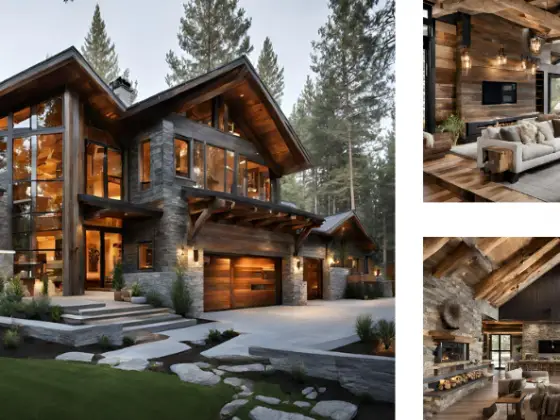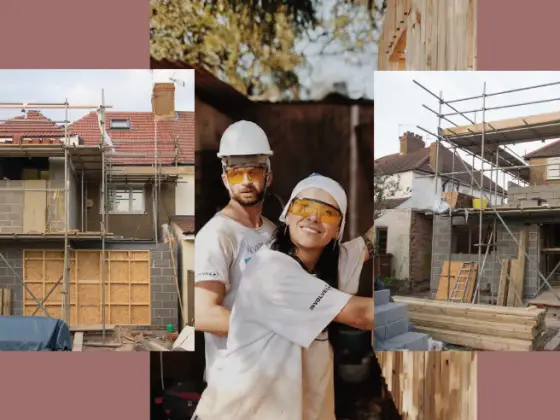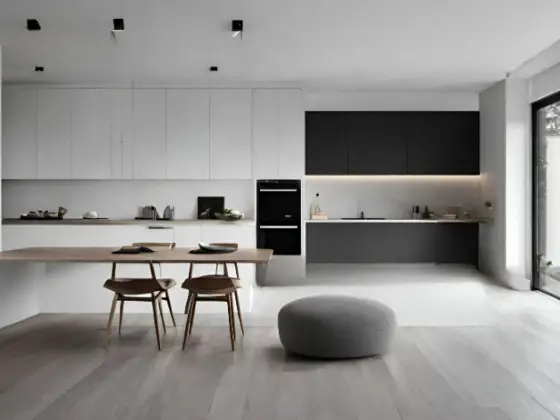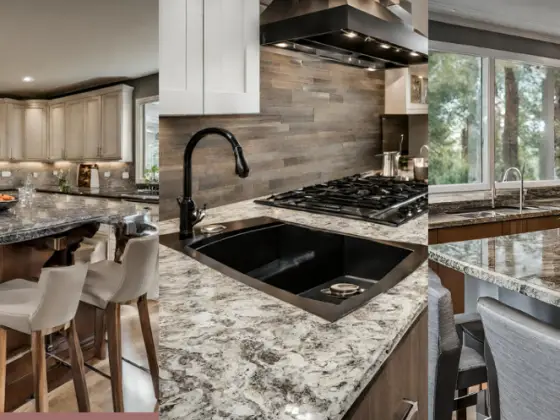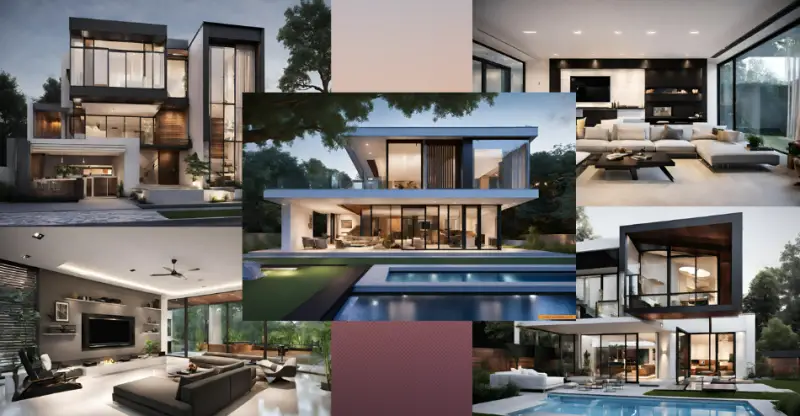
Modern design is more than just aesthetics; it’s an approach that encapsulates the spirit of the contemporary era, blending form and function into a harmonious whole. To understand the essence of modern design, it’s essential to embark on a journey through its historical evolution, delve into its distinctive characteristics, explore the influential designers who shaped the movement, and discover how technology has become an integral part of the design process.
Historical Evolution of Modern Home Design
Early Modernism (1900–1930)
The roots of modern design can be traced back to the early 20th century, where a departure from traditional ornamentation and an emphasis on simplicity and functionality emerged. Designers like Walter Gropius and the Bauhaus school led this revolution, focusing on geometric shapes and industrial materials.
Mid-Century Modern (1930–1960)
Characterized by clean lines, organic shapes, and a connection to nature, Mid-Century Modern design, popularized by designers like Charles and Ray Eames, brought a warm and inviting feel to modern spaces.
Contemporary Modern Design (1960–Present)
Today’s modern design continues to evolve, with a focus on sustainability, minimalism, and technology integration. Designers like Philippe Starck exemplify the fusion of innovation and style in contemporary modern design.
Key Characteristics
Clean Lines and Minimalism
Modern design hinges on clean lines, simplicity, and the “less is more” philosophy. It eliminates excess, resulting in uncluttered spaces that prioritize functionality without sacrificing aesthetics.
Functionality and Utility
Every element in modern design serves a purpose. Furniture, decor, and architectural details are carefully chosen to optimize utility, ensuring that each piece contributes to the overall functionality of the space.
Use of Innovative Materials
Modern designers embrace materials such as glass, steel, and concrete. These materials not only provide a sleek, futuristic appearance but also underscore the commitment to cutting-edge design.
Influential Designers
Le Corbusier
Le Corbusier’s revolutionary ideas on architecture and urban planning left an indelible mark on modern design. His belief in the harmonious blend of function and aesthetics paved the way for modernism’s principles.
Charles and Ray Eames
The Eameses are synonymous with mid-century modern design. Their iconic furniture pieces, such as the Eames Lounge Chair and the Eames Molded Plastic Chair, embody the essence of modern design by seamlessly combining form and function.
Philippe Starck
Philippe Starck’s avant-garde designs span from interiors to everyday objects. His eclectic approach to modern design blurs the lines between art and utility, often with a whimsical touch.
The Role of Technology
Impact of Technology on Modern Design
The digital age has significantly influenced modern design. Computer-aided design (CAD), 3D printing, and other technological advancements have opened up new frontiers, allowing for intricate, precision design.
Integration of Smart Design
The modern era has seen a surge in the integration of smart technology into design. From smart lighting and thermostats to furniture with built-in charging ports, technology has become a seamless part of modern living spaces.
Form Follows Function
Understanding the Principle
The mantra “form follows function” emphasizes that the design’s aesthetic should be a natural outcome of its intended purpose. This principle ensures that every design element serves a practical function.
Examples in Modern Design
Modern buildings and furniture pieces, such as the Barcelona Chair and the Sydney Opera House, exemplify how form beautifully complements functionality, resulting in timeless, iconic designs.
Sustainability in Modern Design
Eco-Friendly Materials
Modern designers increasingly turn to sustainable, eco-friendly materials like bamboo, reclaimed wood, and recycled metals. This eco-conscious approach addresses environmental concerns and aligns with modern design’s forward-thinking ethos.
Energy Efficiency in Design
Energy-efficient design practices, such as maximizing natural light, optimizing insulation, and using efficient heating and cooling systems, are integral to modern design. These strategies not only reduce environmental impact but also contribute to long-term cost savings.
Minimalism and Decluttering
Embracing Minimalist Aesthetics
Minimalism fosters an environment of tranquility. It encourages the removal of non-essential elements, leaving only what’s necessary to create serene, uncluttered spaces.
Reducing Clutter in Modern Spaces
Modern design embraces organization solutions like hidden storage, open shelving, and sleek, multi-functional furniture to maintain a sense of minimalism and ensure clutter-free living.
Open Floor Plans
Advantages and Drawbacks
Open floor plans in modern design create a seamless flow between spaces, promoting social interaction and flexibility. However, it can also pose challenges in terms of privacy and noise control.
Creating a Sense of Space
By removing walls and using a cohesive color palette, modern design fosters a sense of space and continuity, making even smaller areas appear more expansive.
Use of Natural Light
Maximizing Natural Light
Modern design often incorporates large windows, skylights, and glass walls to maximize natural light. This not only reduces the need for artificial lighting but also connects indoor spaces with the outdoors.
Blending Indoors and Outdoors
The strategic use of glass doors and large windows blurs the boundaries between indoor and outdoor spaces, enhancing the overall experience of modern living.
Incorporating Art in Design
Art as a Focal Point
In modern design, art is not confined to galleries; it becomes an integral part of the living space. Bold, vibrant artwork can serve as a focal point in otherwise minimalist interiors.
Balancing Art with Design
Harmonizing art with the overall design aesthetic is crucial. Artwork should complement the surrounding space and create a cohesive visual narrative.
Bold Color Choices
Contrasting Colors
Modern design often uses a neutral color palette with bold, contrasting accents. This juxtaposition adds depth and visual interest to interiors.
Pops of Color in Modern Interiors
A single piece of brightly colored furniture or an accent wall can inject personality and energy into modern spaces while maintaining the overall clean and sleek look.
Furniture Design
Iconic Modern Furniture Pieces
Pieces like the Barcelona Chair, the Noguchi Coffee Table, and the Wassily Chair exemplify modern design with their timeless appeal and functional elegance.
Functionality in Modern Furniture
Modern furniture is designed to be more than just visually pleasing. It also prioritizes comfort, durability, and adaptability to changing needs.
Scandinavian vs. Industrial Modern
Contrasting Styles
Scandinavian modern design embraces simplicity, natural materials, and a cozy, hygge feel. In contrast, industrial modern design incorporates raw materials, exposed structural elements, and a more urban aesthetic.
Choosing the Right Modern Style for You
Understanding the nuances of different modern design styles allows you to make informed choices that align with your personal preferences and the functionality of your space.
Modern Design in Architecture
Iconic Modern Buildings
Architectural marvels like the Guggenheim Museum in Bilbao and the Sydney Opera House reflect the influence of modern design in creating iconic, cutting-edge structures.
Principles in Modern Architectural Design
Sleek lines, innovative use of materials, and a strong connection to the surrounding environment are fundamental principles in modern architectural design.
Modern Design in Interior Spaces
Modern Kitchens
Modern kitchen design emphasizes functionality, clean lines, and a seamless blend with the rest of the living space. Minimalist cabinetry and high-quality materials are key features.
Modern Living Rooms
In modern living rooms, comfort meets style with modular furniture, monochromatic color schemes, and a focus on open spaces that encourage social interaction.
Balancing Warmth and Minimalism
Use of Textures and Materials
Incorporating warm materials like wood and textiles can soften the austere aspects of minimalism, adding a welcoming touch to modern spaces.
Adding Coziness to Modern Spaces
Elements such as area rugs, throw pillows, and soft lighting contribute to the creation of inviting, cozy corners within modern interiors.
Mixing and Matching
Blending Modern and Traditional Elements
The interplay between modern and traditional design elements creates a dynamic and eclectic look, offering a unique, personalized expression.
Achieving a Harmonious Design
Harmonizing these elements requires a careful balance that ensures they coexist seamlessly, contributing to a cohesive and striking interior.
Challenges in Modern Design
Balancing Aesthetics and Function
Finding the equilibrium between aesthetics and practicality can be challenging in modern design, as the quest for minimalism sometimes conflicts with the need for comfort.
Achieving Timelessness
The risk of design trends becoming dated can be a concern. Striving for a timeless appeal is essential in ensuring the longevity of modern design choices.
Modern Design and Cultural Influences
Global Inspirations in Modern Design
Modern design is a dynamic, global conversation. Influences from different cultures enrich modern aesthetics, contributing to a diverse design landscape.
Regional Variations
Different regions incorporate cultural elements into modern design, resulting in unique, localized interpretations of the style.
Budget-Friendly Modern Design
Affordable Modern Decor Tips
For those on a budget, cost-effective modern design can be achieved through careful selection of materials, DIY projects, and thrifty shopping.
Upcycling and DIY Projects
Repurposing old furniture and taking on DIY projects not only save money but also allow for personalized, one-of-a-kind design elements.
Modern Design in Different Rooms
Bedrooms
Modern bedrooms emphasize tranquility and simplicity, with uncluttered spaces, neutral color schemes, and comfortable, minimalist furniture.
Bathrooms
In modern bathrooms, sleek fixtures, clean lines, and efficient use of space create a spa-like environment that embodies modern design principles.
Modern Design for Businesses
Modern Office Spaces
Contemporary office design focuses on productivity and collaboration, with open layouts, ergonomic furniture, and integrated technology.
Modern Retail Environments
Retail spaces incorporate modern design to create immersive shopping experiences that engage customers through innovative displays and technology.
Trends in Modern Design
Sustainability and Eco-Friendly Practices
As environmental awareness grows, modern design trends increasingly emphasize sustainability, with eco-friendly materials and energy-efficient solutions.
Biophilic Design
Incorporating nature into modern spaces is a growing trend. Biophilic design integrates natural elements like plants and natural light to improve well-being.
Conclusion
Embracing modern design is about understanding its rich history, key principles, and the dynamic influence of technology. It’s about crafting functional, aesthetically pleasing spaces that reflect the contemporary spirit. Modern design isn’t just a style; it’s a way of life, a testament to innovation, and a commitment to a brighter, more sustainable future.
